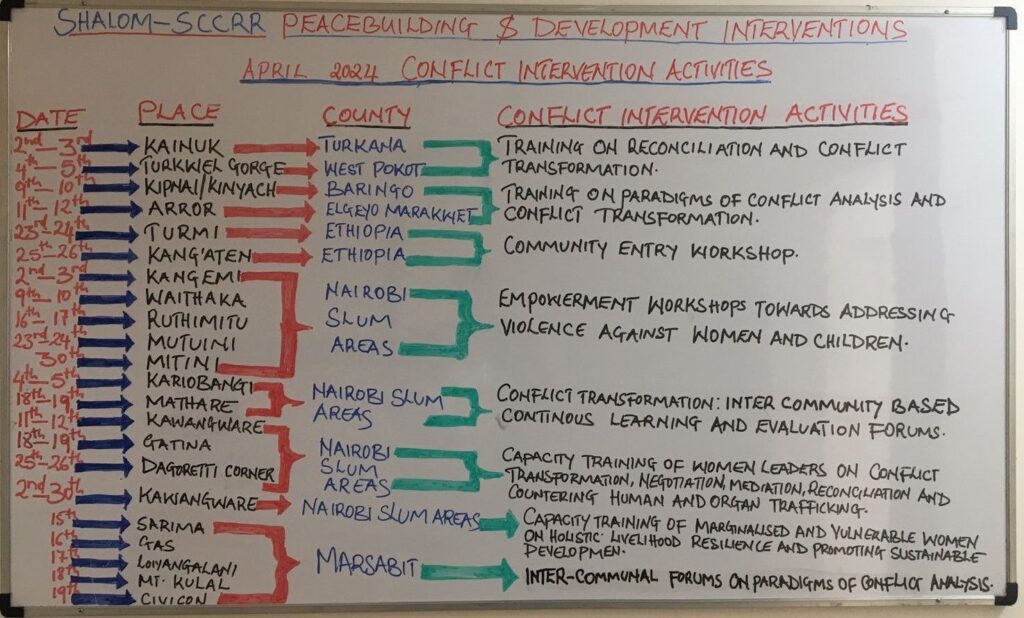
Minister McHugh with Modester Alain from Parkatti at the workshop
By Paulson Erot Tadeo
For many years, the persistent inter-ethnic conflict between the Turkana and the Samburu communities residing in the larger Samburu County have resulted in the loss of many lives, destruction of property, abandoned villages, loss of hundreds of livestock, insecurity in the connector roads, disruption and closure of schools, markets being inoperable and enormous negative impact on development projects initiated in this conflict zone.
 Since 2013, SCCRR has been intervening in this conflict area by equipping the selected key influential community leaders, both men and women, with analytical skills and techniques of peace-building. These community leaders have since become the pillars of peace contributing immensely in making their communities the architects and drivers of their own destiny. Moreover, by recognizing and acknowledging that peace and development are inseparable, SCCRR has been supporting more than ten inter-ethnic schools in this area by supplying building materials, sanitary supplies, access to clean and safe water, desks, tables, solar panels, text books and other necessary learning materials. This has gone further in promoting and stabilizing the intercommunal learning process in the area.
Since 2013, SCCRR has been intervening in this conflict area by equipping the selected key influential community leaders, both men and women, with analytical skills and techniques of peace-building. These community leaders have since become the pillars of peace contributing immensely in making their communities the architects and drivers of their own destiny. Moreover, by recognizing and acknowledging that peace and development are inseparable, SCCRR has been supporting more than ten inter-ethnic schools in this area by supplying building materials, sanitary supplies, access to clean and safe water, desks, tables, solar panels, text books and other necessary learning materials. This has gone further in promoting and stabilizing the intercommunal learning process in the area.
In less than four years of intervention, SCCRR’s effort has registered significant results witnessed through increased interaction between the two rival communities from Tuum and Parkatti; operational markets; undisrupted learning process in schools; improved security and transport in the connector roads; and the general de-escalation of inter-ethnic raids and counter-raids between the two communities.

Irish officials hear from Shalom participants.
After taking the selected key influential community leaders through a series of intensive and progressive trainings over the last three years, separately, SCCRR brought together the nominated representatives for the first time in a face-to-face community dialogue and trust-building peace meeting in Tuum on 30th November – 1st December 2016. The two-day meeting was aimed at laying down the foundation for the problem solving workshops between the two communities from Parkatti and Tuum. The problem solving workshops are intended to enable the representatives of these communities to come up with some resolutions and practical strategies, on behalf of the respective communities, that will help them to transform and strengthen the injured relationship and work together in cultivating sustainable interdependent peace and development projects between them.

The delegation visited Simale Primary School supported by SCCRR with Mr. Peter Lessoni and Bishop Pante from the Diocese of Maralal
It was on the second day of the meeting held in Tumu (Samburu County) that the delegation from Ireland led by the Minister of Diaspora and Overseas Development, Mr. Joe McHugh, the Irish Ambassador to Kenya, Mr. Vincent O’Neill, Director General of Irish Aid, Mr. Michael Gaffey, Ms. Nicola Brennan and Ms. Rose Gauhan, witnessed SCCRR’s interethnic peace and development work first-hand. The delegation was able to interact with SCCRR’s peace committees, some of the community members, the women groups, government officials, warriors and school children. The delegation also visited Tuum Primary and Simale Primary schools to witness the developmental assistance done by SCCRR. Furthermore, they visited the town of Kawap, once having a thriving population of 3,000, but deserted since 2012 due to former conflict attacks between the Samburu and the Turkana.
Reacting to Shalom’s intervention in the conflict zone, Minister Joe McHugh said, “The work that Shalom is doing shows two things: a massive vision for the region and leadership. I have met some of the team today they are doing great work, they are working on peace but not just peace for peace-sake they are working on development as well.”
The Minister was impressed with Shalom’s strategy of bringing the two ethnic communities together and went ahead to praise the local community for agreeing to come together insisting that by coming together, they will be stronger despite their differences. “We thank the Shalom team for giving us this rare insight into the work that they do,” the Minister concluded.

Minister McHugh presents solar panels the head teacher of Tuum Primary School Mr. Alois Tipaku
Ambassador Vincent O’Neill thanked SCCRR for the opportunity to come, to see, listen and learn from its incredible peace and development work. He was also proud to see Irish organizations, like Shalom, working in diverse and remote parts of Kenya and improving peace and development aspects of these communities. Mr. Michael Gaffey, speaking to the leaders of both communities echoed these sentiments stating, “The most important thing for peace and for development is to have a community that is united and working together… We are very, very grateful to Frs. Patrick Devine and Oliver Noonan for bringing us here”. Shalom continues to journey with and assist both communities through empowering them to be the architects of peace seeking non-violent means to resolve the root causes of their conflict.

Fr. Devine, Minister McHugh, the Shalom team and villagers pose after their meeting.

